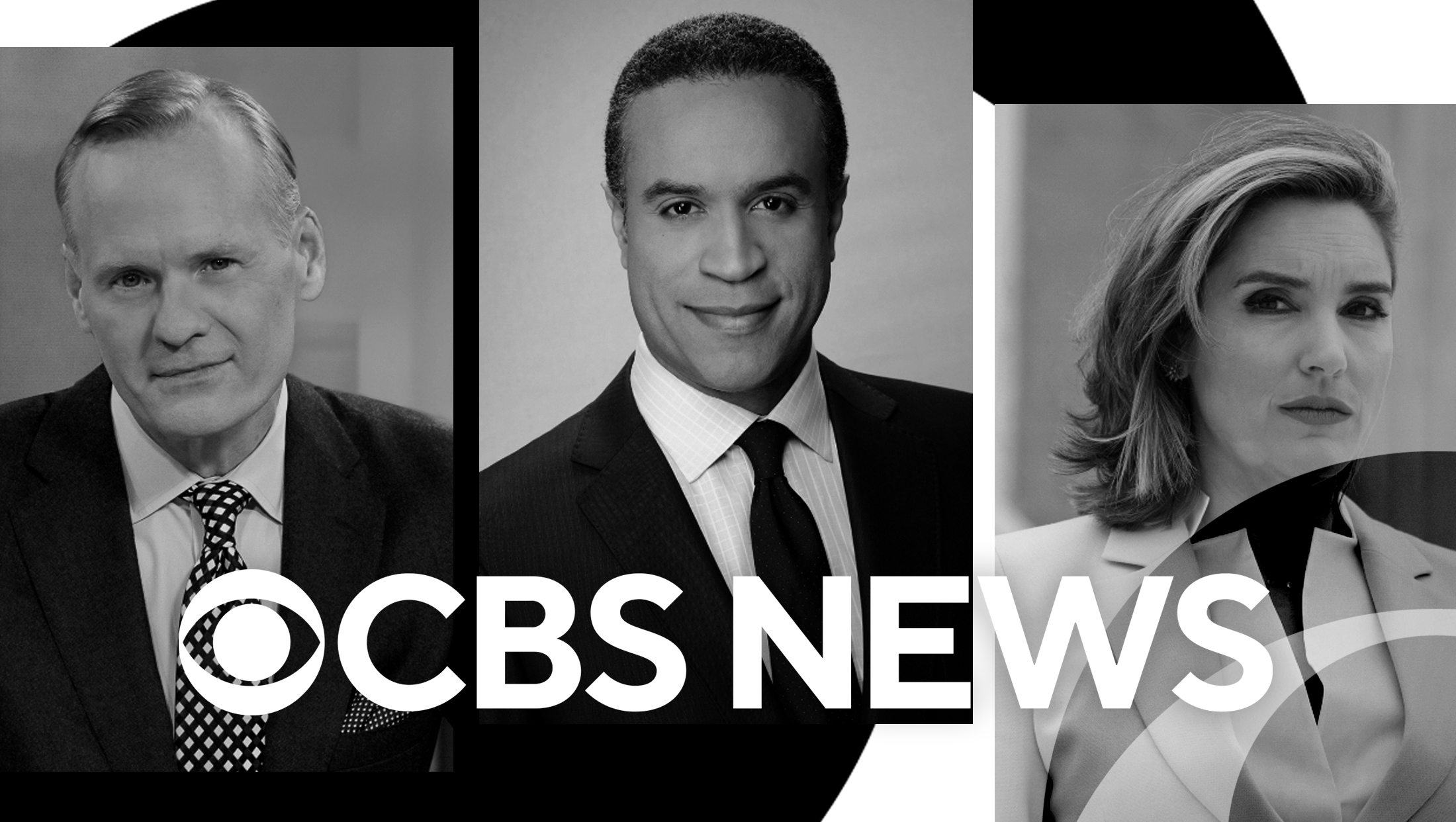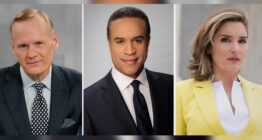Multiple anchor approaches, like the one CBS is preparing to try, have mixed record

Weekly insights on the technology, production and business decisions shaping media and broadcast. Free to access. Independent coverage. Unsubscribe anytime.
With CBS News‘ decision to introduce a new version of “CBS Evening News” with dual permanent co-anchors and an ensemble approach to both on-air talent and behind-the-scenes editorial teams, the network is venturing into things that networks have tried before.
The use of two or more anchors is not new to network evening newscasts, though it has notably been met with mixed success.
Incidentally, CBS notably has the least experience outside of the single anchor format of its two rivals ABC and NBC.
A history of multiple anchors on evening network news
CBS News
CBS itself experimented with a two-anchor format from 1993 to 1995, when Connie Chung was named co-anchor of the “CBS Evening News,” a tenure that was sandwiched between Dan Rather’s 1981 to 2005 run as solo anchor of the broadcast.
The broadcast typically featured both Chung and Rather in the same studio, but sometimes one of them would travel to the location of major news stories.
CBS would never return to a dual-anchor format for its evening newscast until the 2024 plans were announced.
ABC News
ABC’s history of network-level news includes several early attempts in the 1940s and 1950s at dual anchors. In 1965, Peter Jennings anchored the newscasts solo for two years, before being sent to London, reportedly to gain more experience.
The “ABC Evening News” had solo anchors until 1969, when Howard K. Smith began co-anchoring with Frank Reynolds. Reynolds left the broadcast in 1970 when Harry Reasoner moved from CBS to ABC. He anchored alongside Smith until 1975, when Smith shifted to providing commentary. Reynolds anchored by himself briefly before Barbara Walters became co-anchor in 1976, but that pairing was short-lived.
In 1978, the network relaunched the broadcast as “World News Tonight” and introduced a trio of anchors — each located in a different region.
Reynolds returned as lead anchor, broadcasting from Washington, D.C. Max Robinson, anchored national news segments from Chicago and Jennings handled international headlines from London. Walters was given the role of anchor of special coverage and would appear from New York for select coverage.
This formula proved successful and lasted until 1983 when Reynolds, after taking time off for medical issues, died July 20, 1983. During Reynold’s absence, Jennings and Robinson shared anchor duties.
On Aug. 9, 1983, the networks opted to put Jennings in the role of sole anchor and began producing most of the broadcasts from New York.
Jennings would see his name officially added to the program tile in 1984 and the broadcast continued with him at the helm until 2005 when he was diagnosed with lung cancer. He died Aug. 7, 2005.
That year marked the end of an era for broadcast networks; both “CBS Evening News” anchor Rather and “NBC Nightly News” anchor Tom Brokaw had retired around the same time, meaning all of the “big three” U.S. networks saw anchor turnover within a year of each other.
In 2006, ABC announced that Elizabeth Vargas and Bob Woodruff would co-anchor the broadcast. It also embarked on an ambitious plan to provide three live feeds each day (most networks produced two at the time), including separate ones for the mountain and Pacific time zones.
That idea ended up being short lived after Woodruff was seriously injured while reporting from Iraq and could not appear on air while being treated for his injuries. Vargas then announced she was pregnant with her second child and would leave the anchor desk later in 2006, when the broadcast reverted back to solo anchors.
Charles Gibson anchored from 2006 to 2009, while also being renamed simply “World News.” Diane Sawyer then anchored from 2009 to 2014, with current anchor David Muir taking over Sept. 1, 2014 (meaning his 10th anniversary as anchor of the broadcast is quickly approaching). Muir’s appointment also saw the program add the word “Tonight” back to its title, along with “ABC” being tacked on in front.
NBC News
Prior to “NBC Nightly News,” NBC broadcast the “Huntley-Brinkley Report” from 1956 to 1970. Chet Huntley would report from New York, with David Brinkley appearing from Washington, D.C. The format saw Huntley handling most segments with Brinkley brought in to cover political news.
“Huntley-Brinkley” ended in 1970 when Huntley retired. Brinkley, John Chancellor and Frank McGee would then share anchor duties in various combinations, including either solo or dual-anchor formats. Occasionally all three would appear on the same broadcast. NBC kept Brinkley in Washington and based McGee in New York. Chancellor was ferried back and forth between the cities.
In 1971, Chancellor became solo anchor. Brinkley returned full time to the broadcast in 1976, after contributing a “Journal” segment several times each week. At first, NBC would typically have both in New York but Brinkley eventually switched back to appearing from D.C.
The arrangement ended in 1976, when Chancellor was made solo anchor again. He would step down in 1982 when Tom Brokaw took over, marking NBC’s return to the solo anchor format it uses to this day.
More about CBS’s plans
After “Evening News” anchor Norah O’Donnell announced she would step down from the broadcast after the 2024 election, CBS would solidify its plans two days later on Aug. 1, 2024.
Plans call for John Dickerson and Maurice DuBois to become the two primary co-anchors of “Evening” at a date yet to be determined.
Dickerson has filled in on the “Evening News” in the past and has co-anchored the network’s morning newscast. He also hosted “Face the Nation,” among other roles. He is currently anchoring “The Daily Report with John Dickerson” (originally “Prime Time”) on CBS News 24/7, the network’s free streamer.
DuBois, meanwhile, is an anchor at WCBS in New York, which is owned by CBS. The station and network both operate at the CBS Broadcast Center.
“Face the Nation” moderator Margaret Brennan, who is also the network’s chief foreign affairs correspondent, will also appear as a “support” anchor from Washington, D.C. when the news cycle shifts toward political or foreign news stories.
CBS is also pulling in Lonnie Quinn, also of WCBS, as the lead weather forecaster for the broadcast.
Dickerson, DuBois, Brennan and Quinn are all expected to continue their existing roles.
The strategy
So, what is CBS’s strategy by taking this approach?
The network has said it plans to offer a “new format” that will eschew “traditional headlines that move from one clipped story to the next.”
It’s worth noting that “Evening” tried out a “top stories” digest segment from early June to mid-July 2024, which allowed its to showcase three to four correspondents on-air at a faster pace than traditional packages. The reports still included a brief intro by O’Donnell and were also peppered with references to “Norah,” which could have been seen as a way to emphasize the team-based approach to the news.
It also creating an ensemble approach to the broadcast elsewhere on its team, with “60 Minutes” producer Guy Campanile expanding his duties as executive producer of “Evening News.” “60 Minutes” executive producer Bill Owens is also becoming supervising producer of “Evening.”
CBS has also said it plans to offer “60 Minutes” correspondents the opportunity to break news on “Evening,” an approach it has used in the past. It will also leverage Brennan’s dual duties as a way to showcase the “Face the Nation” brand and content throughout the week.
All told, this approach, if successful, could help create a more cohesive CBS News brand stretching across three of its major productions.
Cost savings?
Although the terms of the new producers and anchors’ deals were not revealed and CBS did not mention cost as factor in its announcement, it’s hard to not see the move as a way for the network to realize cost savings by having existing staffers take on more duties.
Even if the anchors and producers are given salary bumps to account for their increased responsibilities, the network is still likely saving some money by not bringing in separate staff and incurring the costs of “base” salaries and benefits.
CBS News and Stations, as part of Paramount Global, is expected to face cost-cutting after it finalizes its merger with Skydance Media, according to previous announcements.
The network already pursued at least some cost savings when it renewed O’Donnell’s deal in 2022, with the anchor reportedly taking a pay cut to continue appearing on the last-place broadcast. CBS did not announce if her pay structure would be reconfigured once she leaves “Evening.”
Other things to consider
As the lowest-rated evening newscast, the “CBS Evening News” has a lot of room to grow so taking on a new format could help it stand out from its rivals.
In practice, there is little differences between much of the core content on the “big three” newscasts each evening, with top stories often covered in similar orders and lengths. Human interest and lifestyle segments are often more unique to each broadcast.
Both ABC and NBC also have gradually shifted toward lengthier headlines segments at the top of the broadcast. Although still meant to grab viewers’ attention and keep them tuned in, these segments have, especially at ABC, become almost a newscast within a newscast.
“Evening” has notably changed up its open and tease headlines numerous times since O’Donnell took over, but has typically focused on a “less is more” approach to the segment, opting instead to get viewers into actual packages sooner than its competitors. Its latest update to the first few minutes of airtime is even more slimmed down, typically coming in at around 40 seconds compared to NBC’s 90 seconds and ABC’s two minutes-plus.
If CBS continues this approach — perhaps even removing any tease or headline before the open, it could potentially stand out among its competitors.
“Evening News” has also experimented with a headlines segment that airs after the anchor greeting, an attempt to duplicate the signature “EyeOpener” segment on “CBS Mornings,” but there’s no word on if the new format might see something similar return.
Production
CBS did not announce if it plans to update the set “Evening News” and “Face the Nation” share in Washington, D.C., prior to the debut of the new broadcast.
It could potentially perform updates starting in late October of November of 2024 by having “Evening” and “FTN” temporarily shift to different locations ahead of the election (CBS has broadcast its election night coverage from New York in recent years).
Currently, the D.C. studio is wrapped largely in video walls, with vertical supports and headers being the primary hard scenic. This allows the for unique looks for shows that originate from the studio.
Assuming Brennan and other Beltway correspondents use this studio, it’s easy to see how the network could update the video wall graphics to update whatever the new look for “Evening” ends up being and duplicating that in New York to give both locations a consistent look.
While CBS did confirm Dickerson and DuBois will originate from the CBS Broadcast Center in New York, it did not indicate where its studio would be.
Prior to moving to Washington, the broadcast used Studio 57, which it shared with “CBS This Morning” before that show rebranded as “CBS Mornings” and moved to Times Square. The space has since been renovated for the network’s CBS News 24/7 streamer.
Studio 47, the longtime home of “Evening” going back to at least the Rather days, has since been renovated to serve as a primary newsroom space for the network, but still maintains an anchor setup that is used on weekends and other select segments and coverage.
Dickerson’s existing “The Daily Report” uses both spaces for production, though the bulk of the broadcast is typically done from Studio 47.
It’s possible “Evening” could move back into Studio 57, though the space notably lacks any large video walls. It could potentially be fairly easy to add video walls to this space or any other studio within the center. Many of the CBS Broadcast Center’s major studio spaces are spoken for, so there’s not a significant amount of other options.
The network did recently install a new extended reality space, so it could potentially opt to use virtual set technology to create a New York home for the show.
Studio 57 already has video walls and could potentially become home of “Evening” again, though, assuming the schedule remains the same, Dickerson’s “The Daily Report” could potentially end up running right into the 6:30 p.m. airtime for “Evening,” limiting the amount of time to switchover between broadcasts (it’s also not clear how CBS will handle the fact “Report” runs from 6 to 7 p.m.).
It’s typical to have talent on-set well before airtime to pre-tape select segments and also be available for live hits with major affiliates to preview the upcoming broadcast.
It’s also possible “Daily” would move elsewhere, such as Studio 47, to make room for “Evening.”
It’s worth noting that the network’s Studio 1515 in Times Square is actually probably better equipped to match the Washington, D.C. studio, if that’s what the plan ends up being, but it likely would be difficult to shuttle the anchors between the two locations reliably.
Correction: An earlier version of this story misstated the year Peter Jennings first anchor for ABC News. It has been corrected.







tags
ABC, ABC News, ABC World News Tonight, Barbara Walters, Bill Owens, Bob Woodruff, CBS, CBS Broadcast Center, CBS Evening News, CBS News, CBS News and Stations, Charles Gibson, Chet Huntley, Connie Chung, dan rather, David Brinkley, david muir, diane sawyer, Elizabeth Vargas, Frank McGee, Frank Reynolds, Guy Campanile, Harry Reasoner, Howard K. Smith, john chancellor, john dickerson, Lonnie Quinn, Margaret Brennan, Maurice DuBois, Max Robinson, NBC, NBC News, NBC Nightly News, Norah O'Donnell, Peter Jennings, Studio 1515, studio 47, studio 57, The Daily Report with John Dickerson, tom brokaw
categories
Broadcast Business News, Featured, Network Newscast, People